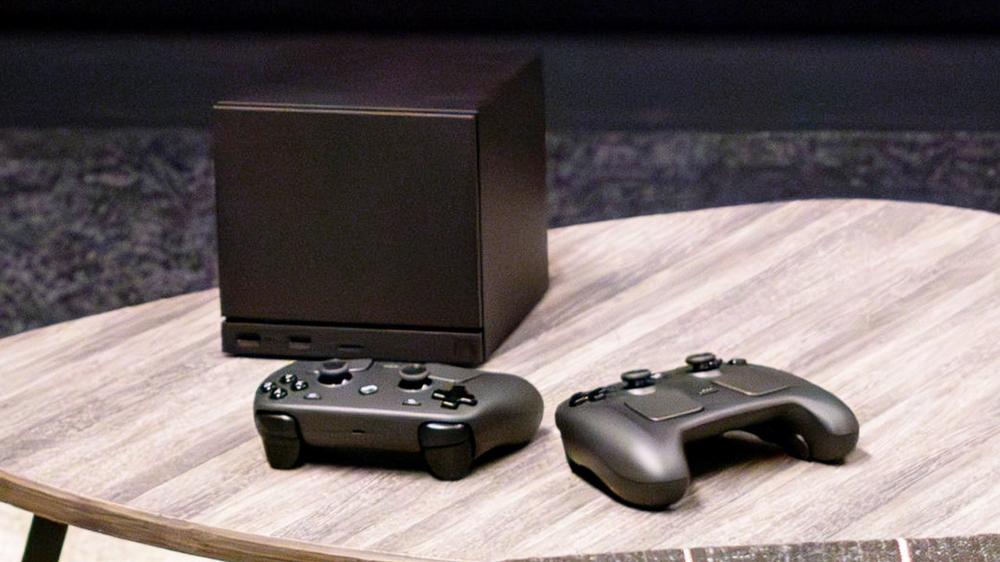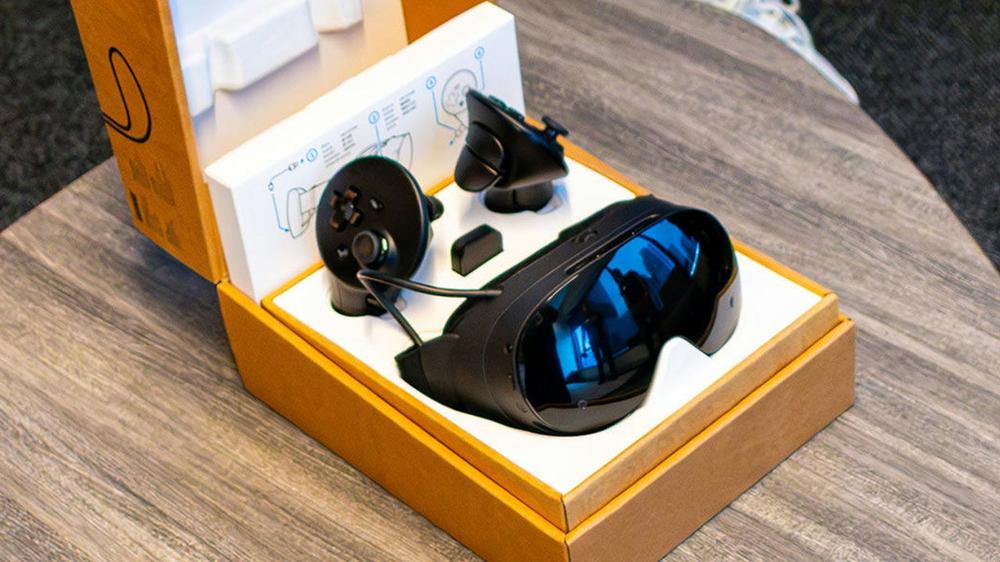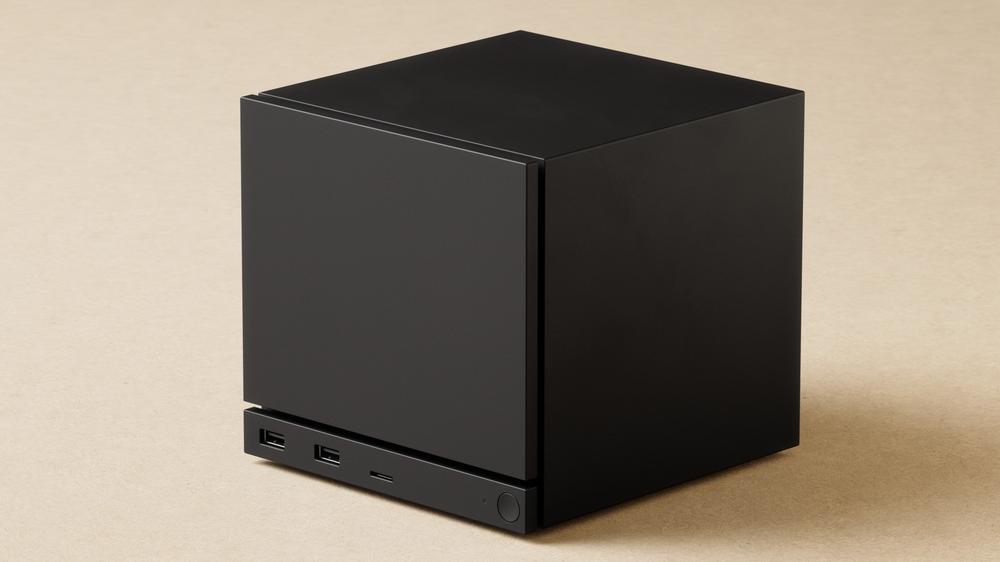Steam Machines are back for the first time since Valve teamed up with manufacturers like Alienware and Lenovo back in the 2010s. But while those original console-PC hybrids failed because of a lack of game compatibility with the nascent SteamOS, 2022’s Steam Deck has paved the way for the Steam Machine’s return.
This time around, instead of partnering with outside manufacturers, Valve is building and releasing a singular Steam Machine with the goal of being able to run all current games at 4K with upscaling. The secret behind this is an AMD RDNA 3 GPU with power roughly equivalent to an RTX 4060 or RX 7600 mobile graphics card. That might be disappointing to anyone looking to max out everything at a high resolution, but it should have plenty of power while still being relatively affordable (we assume) – Valve hasn’t announced a price for the thing yet.
I spent a day at Valve playing around with this new mini gaming PC, and while I haven’t had the chance to run my usual gamut of gaming benchmarks, it looks like the new Steam Machine might be a serious contender for your living room space.
What’s Changed?
On the surface, the new Steam Machine seems a lot like the old Steam Machine. They’re both gaming PCs with a modest spec, and meant to run games on Valve’s own Linux-based SteamOS. But while the original machines had trouble selling, mostly due to high prices and a lack of Linux compatibility at the time, SteamOS has changed a lot over the last decade.
The biggest part of that is Proton, Valve’s compatibility layer that essentially translates Windows games to Linux, allowing you to play most of Steam’s vast catalog of games on SteamOS, even if they don’t officially support Linux. Anyone that’s used a Steam Deck over the last few years will know that most games run extremely well on SteamOS, sometimes even with performance that exceeds equivalent Windows 11 machines, as was the case with the SteamOS version of the Lenovo Legion Go S. There are a few exceptions – notably some online multiplayer games with anti-cheat software that doesn’t play nice with SteamOS, like Battlefield 6 and Destiny 2 – but for the most part, if it’s on Steam, it’ll run on SteamOS.
While I was at Valve playing games on the Steam Machine, the company had a wide variety of games installed to show it off. The PC ran everything from Cyberpunk 2077 to Silent Hill F without any major issues – though the latter did have some performance trouble. Obviously, once I get the Steam Machine in the lab, I’ll be able to run a wider variety of games to see just how flexible it is, but for the time being, it seems like most games will run.
Luckily, Valve is also taking the Steam Deck Verified program from the Steam Deck and duplicating it for the Steam Machine. Soon there will be three different verification badges: one each for the Steam Deck, Steam Machine and the Steam Frame, the company’s new VR headset. Because the hardware isn’t actually out yet, I’m not sure how widespread this will be, but Valve has been very successful with the Steam Deck Verified program, to the point where I use it to gauge whether games will run well on other PC handhelds.
Design
The Steam Machine might be a gaming PC, but it doesn’t really look like one. It’s a tiny black box with a slim RGB lightbar across the front, mostly meant to indicate that it’s on. And when I say it’s tiny, I mean it: the PC is a cube that measures roughly 6-7 inches on each side, and appears less than half the size of the Xbox Series X. It’s closer in size to a GameCube.
The front panel is magnetic, too, and can be swapped out to customize the way the console looks. For instance, when I was at Valve, I saw a Steam Machine with a wood panel, which contrasted beautifully with the rest of the all-black chassis. Valve hasn’t confirmed whether or not it will be selling alternative front panels, but the company will release 3D Printing files so you can make your own, and third-party accessory companies will undoubtedly sell plenty of custom options for you to choose from.
Because this is ostensibly a desktop PC, there’s a wealth of ports on offer, with two USB-A ports and a MicroSD port on the front. In the back you’ll find a DisplayPort, HDMI, two USB-A ports and a USB-C port, along with the power connector. What’s impressive, considering the Machine’s size, is that the actual power supply is internal, which means you don’t have to worry about fitting a giant power brick in your entertainment center.
Valve did open up the Steam Machine so I could get a brief look inside, and what I saw was impressive. A bulk of the space is taken up by a giant heatsink, which has an exhaust fan at the back that sucks air through the front and bottom of the device and expels it through the rear to keep the device operating cool. It’s a bold design, especially considering that the Steam Machine’s GPU is operating with a TDP (thermal design power) of 110-130W. I’ll have to wait and see how its thermals balance out when I get the system in for review early next year.
The bottom of the device houses the SSD, which will either be a 512GB or a 2TB drive, depending on which version you buy. This drive is easily replaceable by the user. Just like the Steam Deck, the Steam Machine will ship with an NVMe 2230 drive. However, unlike Valve’s handheld, the SSD slot has space for a full-sized NVMe 2280 drive, which are both more affordable and easier to find on store shelves. Don’t get too hopeful about upgrading the device beyond the storage, though – the rest of the components are soldered on and will not be upgradeable.
That’s a little disappointing, especially given Valve’s history of letting its users do what they want with the hardware. However, if the rest of the internals were user-swappable, it wouldn’t be able to be as tiny as it is. Whether or not that tradeoff is worth it is up to you, but given the Steam Machine’s console-like qualities, it will likely appeal most to people who just want a plug-and-play gaming device. For them, I suspect the lack of upgradeability will be a non-issue – at least until it starts showing its age in a few years.
The Steam Machine will also be available with the new Steam Controller – or without one. No matter whether or not you get the Steam Machine bundled with the controller or not, though, the PC will have the controller’s wireless dongle built-in, so you don’t have to worry about always having one of your USB ports occupied by a little antenna. What’s better, though, is that the Steam Controller that’s bundled with the system will also come with a wireless dongle, which you can use with another system, or just have it on the table next to you to wirelessly charge the controller when you’re not using it.
Tying things up is an RGB light bar that stretches across the bottom of the Steam Machine, just below the removable front panel. Valve tells me that this is primarily meant to be a status indicator, but it is still user-addressable, with 13 lighting zones. I don’t know what kind of software Valve is cooking up for lighting control, though. (One of the pain points with SteamOS right now – at least with the Legion Go S – is that it’s not that easy to customize the RGB around the thumbsticks.) We’ll just have to wait and see what the final software looks like here before rendering judgment.
Specs and Performance
The Steam Machine is powered by a custom chip made by AMD and Valve, with a RDNA 3 GPU with 28 compute units and a TDP between 110-130W, which would place it roughly around a mobile RX 7600 – not exactly the best graphics chip out there. This is paired with a 6-core Zen 4 CPU with a TDP around 30W.
But despite the modest specs, the Steam Machine seems to be a capable gaming PC. I played Cyberpunk 2077 at 4K with the Ultra preset and FSR set to Performance, and the action stayed nice and smooth. I even went into the settings menu and turned on ray tracing, and performance seemed to stay solid – though I didn’t have a frame counter up telling me exactly what kind of frame rate I was getting.
Things were slightly different with Silent Hill F, though. After a lengthy process of installing the shaders – something every game seems to need to do these days – it defaulted to Ultra settings at 4K with TSR (temporal super resolution) instead of AMD’s FSR. At these settings, Silent Hill struggled, chugging along at what seemed like 15-20 fps – not exactly what I’d call playable. After adjusting the settings down to medium at 1440p with FSR enabled, things felt much better, but this just highlights that the Steam Machine is still a gaming PC at the end of the day, for better or worse. Tweaking settings to optimize performance is a time-honored tradition among PC gamers, but again, might be less appealing to people who just want a plug-and-play gaming experience.
Valve says it intends for the Steam Machine to be able to play all current games at 4K with FSR upscaling, but there are going to be plenty of games – especially ones running on Unreal Engine 5 – where you’ll have to lower settings to get it running at a smooth frame rate. Ultimately, I’ll have to get it in the lab to benchmark it to see exactly what it’ll be capable of, but I have little doubt this PC will be running most things – it’s just that the quality settings are definitely going to vary.
It’s likely that over time developers will be able to sense the Steam Machine hardware and automatically set quality settings that are appropriate. After all, many games do that with the Steam Deck now, but only time will tell if the Steam Machine will receive the same treatment. If it does, though, this thing could be a serious contender in the next generation of consoles, especially as the next Xbox looks increasingly PC-like.
Who Is This For?
According to Valve, about 20% of its Steam Deck users used its official dock to connect their handheld to their TV. That might not seem like a lot, but given that Valve has shipped millions of Steam Decks – a first-generation product, mind you – that 20% is not an insignificant amount of people. However, there are limitations to running a Steam Deck on a TV – chief among them is performance.
While the Steam Deck is plenty powerful for running PC games on its 800p display, it can’t really handle higher resolutions very well, especially when you connect it to a 4K TV. The Steam Machine, then, is the answer. This is a living room gaming PC that should be able to play most games at 4K, assuming you’re ok with upscaling from 1080p. But of course, most gaming PCs should be able to do that these days.
And while the Steam Machine will have to contend with similarly spec’d gaming PCs that can be upgraded, I don’t think this is for the traditional DIY hardware enthusiast. Rather, this feels more like a PC for console gamers – people who didn’t play games on PC until the Steam Deck hit the market in 2022. It runs the same operating system and has the same library, only it’ll be able to play games at much higher settings. After all, Valve claims the Steam Machine is up to six times more powerful than the Steam Deck, so it should avoid situations like Baldur’s Gate 3, where the second you load into Act 3 on the handheld, your framerate slows to a crawl.
So, if the Steam Deck made you flirt with the idea of PC gaming, the Steam Machine looks like it’ll be a great next step, especially as games get increasingly more demanding as we head into the next generation of consoles. For everyone else that already has a gaming PC, at least the hardware support for SteamOS is starting to broaden a bit.
Just How Expensive Will This Thing Be?
It’s impossible to talk about PC hardware in 2025 without bringing up the price. Devices from the Asus ROG Xbox Ally X in October to the RTX 5080 back in January have all launched with significantly higher prices compared to what they would have been in previous years. Console pricing hasn’t fared much better, as the Switch 2 hit store shelves at $150 more than its predecessor, while the PS5 and Xbox Series X have both faced price hikes within the last year. Valve hasn’t shared pricing for the Steam Machine yet. The only guidance the company has shared with me was that it will be priced competitively with similarly spec’d gaming PCs.
Keeping in mind that this is running a last-generation GPU and processor, it could mean that pricing might end up being relatively reasonable – but we just won’t know until Valve decides to share more. I’ll update this preview as soon as I find out, but my hope is that Valve keeps the Steam Machine under $1,000. If it wants to compete for Xbox’s and PlayStation’s space in the living room, it’ll have to.
For more coverage of Valve's new hardware, check out our hands-on previews of the Steam Controller and Steam Frame, as well as our analysis of what this could mean for the future of the console and PC landscape.

 Steam Frame Preview – Hands-On With Valve's State-of-the-Art VR Headset
Steam Frame Preview – Hands-On With Valve's State-of-the-Art VR Headset